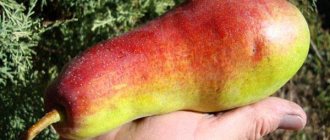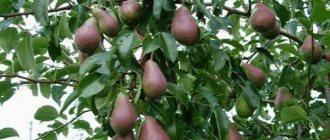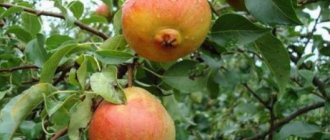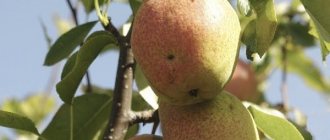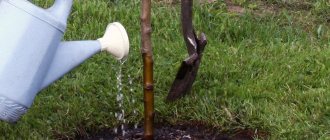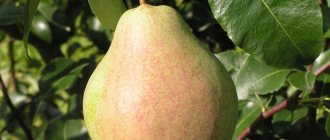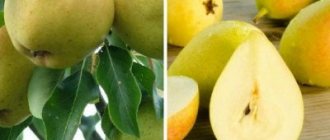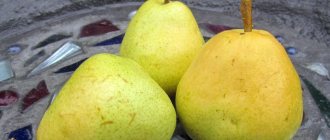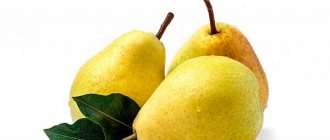general information
Samara beauty pear is an early autumn fruit crop. Its buds bloom late, therefore, flowering occurs later. Harvesting takes place until mid-September.
The harvest should be stored after harvest in a dark and cool place for no more than a month. If you overexpose it, the taste of the fruit will deteriorate.
According to the statement of the breeders, the Samara beauty brings the first more or less good harvests in the fifth year of life. After this, with proper care, it will annually delight gardeners with industrial-level fruit production.
Breeding history
The pear variety Samara Beauty was bred in the Middle Volga region, taking into account the agrotechnical features and climate of this region. Experts believe that this area is ideal for the development of horticulture, as it meets all the requirements for good growth of cultivated plants.
The selection of this variety was carried out by agronomists from the Research Institute of Medicinal Plants and Horticulture “Zhiguli Gardens”, in the Samara region: Kedrina T., Kedrin S., Kuznetsova A.
The “parents” of the Samara beauty were the elite varieties Dessertnaya and Kuibyshevskaya Zolotistaya. In 2006, the variety was officially registered and recommended for cultivation in the Samara region. When planting pears in this region, breeders guarantee the yield and taste qualities stated in the characteristics.
Pear Zhelannaya (Samara dessert) autumn
Useful properties of pears
The pear contains a huge amount of useful substances - fiber, sucrose, glucose, fructose, carotene, folic acid, manganese, iron, iodine, copper, potassium, calcium, magnesium, sodium, phosphorus, zinc, fluorine, molybdenum, pectin, ash and organic acids. Vitamins - A, B1, B2, B3, B5, B6, B9, C, E, P, PP, as well as tannins.
Low calorie product. 100 g of pear contains only 42 kcal, so it cannot cause significant harm to the figure. However, the calorie content of dried pear is 270 kcal per 100 g. It is very nutritious due to its high carbohydrate content, and its excessive consumption can cause obesity.
Pears have been used in folk medicine for thousands of years to treat prostatitis. Within a few days after using pear compote for this disease, a striking effect occurs, and its long-term use leads to a cure.
Pears are used as an antimicrobial agent, the fruits of which create an unfavorable environment for pathogenic bacteria. Pear fruits contain organic acids, which, together with hydrochloric acid of gastric juice, acidify the food in the stomach. Pectin and tannins, found in large quantities in pears, deprive these bacteria of mobility.
The fruits contain the antibiotic arbutin, which kills germs. The antimicrobial effect of pears affects the intestinal flora and microbes that cause inflammation of the kidneys and bladder.
Wild pear is more effective as a bactericidal agent.
Since pear contains more fructose than glucose (and, as you know, fructose does not require insulin for its absorption in the body), this fruit is useful for impaired pancreatic function. Therefore, fresh and dried pears, as well as drinks made from them, are included in diets for obesity and diabetes.
Pear fruits contain unique essential oils, biologically active substances that can increase the body's defenses, resist infectious diseases, have an anti-inflammatory effect and even fight depression.
Pears contain a lot of macro- and microelements: for example, iron, which is necessary for the synthesis of healthy blood cells. Therefore, it is recommended to consume pears for fatigue, dizziness, rapid heartbeat that occurs during intense physical activity, as well as loss of appetite, cracks in the corners of the mouth, poor tissue healing, and even sensitivity to cold - all these are symptoms of iron deficiency in the body.
Pear pulp contains many potassium ions, without a sufficient amount of which it is impossible to imagine the normal functioning of the heart and muscles, because potassium ions are responsible for cell regeneration in the body. So, eating a few pears can quite realistically relieve pain in strained muscles. In addition, with a lack of potassium, tissue growth slows down, nervousness and insomnia appear, a rapid heartbeat is observed due to weakening of cardiac activity, and cholesterol levels in the blood increase. For such symptoms, pear treatment can do a good job.
Decoctions and compotes from dried pears are rich in tannins, which have an astringent effect, which is useful for intestinal disorders. Fresh pears contain quite coarse dietary fiber, which enhances intestinal peristalsis, so you should not eat them if you are upset. But if you have constipation, you should definitely eat compote pears.
Pear compotes are also useful for inflammatory diseases of the urinary tract - this drink increases diuresis and has a beneficial effect on the bladder and renal pelvis. For anemia (anemia), it is useful to eat two large pears every day for lunch as a dessert. In this case, the pears are peeled, the pulp is kneaded with a pestle and mixed with two teaspoons of honey.
Pear also treats acute bronchitis: dilute a dessert spoon of rosehip syrup in a glass of pear juice and drink half a glass three times a day.
Pear treatment can be carried out almost all year round, since the fruits, when dried, retain almost all biologically active substances.
However, remember, after you have eaten a pear, you should not drink raw water, or eat heavy food or meat.
And one more thing: it is strictly not recommended to eat a pear on an empty stomach. An old eastern proverb says: “In the morning, an apple is a rose to the heart! In the morning, a pear is poison to the heart!”
For lung diseases, it is recommended to eat pears, and a decoction of dried pears helps with cough and fever.
Boiled and baked pears are used as an antitussive for bronchitis and pulmonary tuberculosis.
Pear Samara beauty: description and photo
The tree should not be tall - this is a disadvantage. According to standards, it should be average or slightly higher. The pear reaches its maximum growth in a short time. The trunk is covered with green-gray bark.
The main branches grow almost at right angles from the trunk; the crown is densely leafed, oval or round in shape.
The shoots are elongated and the color is brownish-brown. Bare geniculate shoots may show slight curvature.
The tree buds are slightly elongated and protruding. The foliage is slightly curved in the center and colored light green.
Description of fruits
The Samara beauty pear produces large and medium fruits. As a rule, the most beautiful, neat pears appear on an adult tree, the average weight of each is from 140 to 190 grams. However, if the climatic conditions are favorable and the correct agricultural technology is carried out, then the pears can be much larger; a harvest with fruits of an average weight of 350 grams has been recorded.
The Samara beauty pear has fruits of either a classic or elongated “bottle” shape. Initially, their color is green-yellow, and during the period of full ripening, a characteristic scattered red-brown blush appears on the skin. Also, numerous brown-green subcutaneous spots are clearly visible on the skin.
The pear pulp is white, very juicy, but the consistency may seem rough. Inside there is a seed nest containing gray-brown seeds.
The taste of the fruit is sweet, with a slight astringent sourness. If ripening took place in conditions of sufficient heat and sun, the taste will be good. If the season had few sunny days and a lot of rain, then the quality of taste will be only satisfactory. The variety received a tasting score ranging from 3.8 to 4.1 points on a five-point scale.
The Samara beauty pear, the variety of which we describe in the article, is universal in use. It can be consumed fresh, cooked into compotes, and jelly, jam and marmalade are excellent and very aromatic.
Description and varietal characteristics
The Samara Beauty pear variety forms large trees with a dense oval crown. As the crown matures, it takes on a drooping appearance. Predominant fruit formation is observed on ringlets and spears. The shoots are long, tapered, slightly curved, brownish-brown in color.
Fruits are large or medium in size. The average weight of a commercial pear is about 135-145 g. The fruits are elongated and pear-shaped, but asymmetrical ones can also form. The skin is smooth, greenish-yellow in color. A small part of the fruits may have a brown-red, vague blush on the surface.
The pulp of the fruit is white, juicy, and has a sweetish-sour taste. The main harvest occurs in early autumn. It is recommended to eat the collected pears within a month after collection. Long-term storage provokes a deterioration in the taste and appearance of the fruit.
The tree reaches the fruiting stage approximately five years after planting in a permanent place. The average yield of an adult tree is about 32-34 kg. Mature fruit trees have sufficient frost resistance. Young plants and seedlings planted in autumn need protection from frost.
Characteristic
From the fifth year of its life, the Samara beauty pear begins to bear fruit steadily, increasing productivity every year. This rhythm allows for good harvests. As statistics have shown, already in the seventh year more than thirty kilograms of fruit can be collected from one tree.
The presentation of pears lasts for quite a long time, so there are no problems with sales. Transportability is high, which allows you to transport fruits over long distances. Thanks to the dense peel, the pulp does not wrinkle and the shape does not deteriorate.
The advantage of the variety is its high frost resistance. The Samara beauty pear can survive the winter without loss when the temperature drops to -35 degrees. However, if severe frosts are observed, the fruit buds may be destroyed.
The crop can be grown for personal consumption, and it is also ideal for growing gardens on an industrial scale.
Characteristics of the variety
The pear variety Samara Beauty has a medium-sized tree with a dense crown. The shoots are often slightly curved and elongated. The branches are formed at right angles, however, the older the tree, the more the branches droop. The tree is resistant to sunburn.
The flowering period is late. Fruiting begins from 5-6 years of growth and gains greater productivity with each season. According to statistics, one tree already produces about 30-35 kg of fruit in the 7th year. This variety is resistant to major diseases and frost.
The fruits are harvested at the end of September. The fruits have a relatively long shelf life, during which they retain their presentable appearance and taste. After a month, the appearance and taste of pears deteriorate.
Morphology of tree and fruit
The Samara beauty is characterized by a pyramidal crown, which as the tree matures takes on a rounded shape. The shoots extend from the trunk at an obtuse angle, so the pyramidal shape is the main one for this pear. When grown on fertilized soil, shoot growth reaches 20–30 cm per year. Fruiting occurs on the ringlets and spears of shoots from the previous year.
Characteristics of the variety:
- early autumn, self-fertile;
- tree - medium-sized, fast growing;
- shoots are long, straight, brown-brown, extending from the trunk at an obtuse angle;
- foliage - average;
- leaves are medium-sized, oblong, curved in the center;
- fruits - about 135–145 g (quite large), maximum weight - 350 g;
- the shape of pears is elongated pear-shaped, slightly bottle-shaped, with a shallow funnel; there is slight asymmetry of the fetus;
- peel - smooth, with small subcutaneous dots;
- peel color - light green at technical maturity; as it matures, yellow with a bright brown-red blush;
- pulp - white with a yellowish tint, moderately sweet with slight sourness, juicy, medium aromatic;
- tasting rating of the variety - 4.1 points out of 5;
- The yield of the variety is 32–34 kg per tree.
Important! In the first year of flowering, it is recommended to leave no more than 4 ovaries. This stimulates the young pear to further development and will not exhaust it.
Frost resistance of the variety
The frost resistance of the tree is quite high - stable frosts down to -27°C and temporary frosts down to -31°C. With a further decrease in temperature, roots and fruit buds may be damaged. The most destructive for fruit buds is precipitation that freezes with ice on the branches. They are a major cause of bud damage and can result in crop failure. The variety is considered resistant to scab. It is also slightly susceptible to fungal infections.
Productivity
The fruits of the Samara beauty are universal. They are perfect for making desserts, jellies, jams, juices and juice drinks, and are also consumed fresh. The tree grows up to 50 years. During growth, the yield changes as the size of its crown increases. The fruits ripen in early September. Productivity is 30–34 kg of fruits per mature tree
Advantages and disadvantages of the variety
When cultivated in the recommended region, Samara beauty has the following characteristics:
- high frost resistance threshold;
- average precociousness - the first harvest is harvested at 5-6 years of age;
- annual stable fruiting;
- increase in productivity - in the seventh year after planting, the yield will be 30 kg from each specimen;
- late flowering and appearance of foliage;
- resistance to scab;
- excellent consumer characteristics of the crop.
Among the disadvantages, reviews from gardeners note the large dimensions of the pear tree. Such massive specimens require a lot of space on the site. Caring for the crown and harvesting will require additional effort.
The described characteristics make the Samara beauty a welcome guest in private or industrial gardens of the Middle Volga region.
Landing place
The variety is heat-loving, so it is necessary to choose an area that is well lit by sunlight and sheltered from the winds. The tree is not afraid of the scorching sun, and excess shade will lead to a decrease in the sugar content in the fruit.
The soil should be loamy, fertile black soil is also ideal. The Samara beauty pear does not tolerate excessive moisture. If it is not possible to plant a tree in remote places from the close occurrence of groundwater, or the site is located in a lowland where water collects, then it is necessary to provide artificial drainage systems. Ignoring this recommendation will lead to weakening and frequent plant diseases, and then it will die.
Diseases and pests
If the tree grows in a sunny, well-drained area and is properly irrigated and pruned, pests will not have much effect on the yield, nor will diseases. But not all trees are in the same conditions, therefore, despite the resistance of pears to fungal diseases, gardeners periodically spray against major diseases and pests. The two most common diseases affecting pear trees are moniliosis and pear scab.
Did you know? Like apples, sliced pears are susceptible to browning when exposed to oxygen. To prevent oxidation, you can dip the pears in a solution of water and lemon juice.
Samara beauty is considered resistant to scab. The fungus that causes moniliosis overwinters on trees in cracks in the bark. In spring it spreads to young shoots, leaves and fruits. The disease is prevented by the use of bactericidal sprays containing copper or solutions based on it. This can be a 1% solution of Bordeaux mixture. Spraying of trees is carried out in the spring on a bare tree, then in the green cone phase and before flowering. Infected parts of the plant are cut off and destroyed.
The most common pests of pear trees are codling moth, psyllid and spider mite. Damage from insects and mites varies depending on the rootstock, weather conditions and the use of insecticides and miticides.
The larvae of the codling moth butterfly infect the ovaries and subsequently develop along with the fruits themselves. The inside of such a pear is worn away by passages, and on the surface there is a trace of the pest’s penetration inside. To combat the codling moth, treatment with Agravertine solution is used before and immediately after flowering. Use the drug according to the instructions on the package.
The psyllid deforms the leaves by sucking the juice from them. The pest is most often found in the upper parts of the crown. The danger of the psyllid is that when it feeds, it secretes a sticky coating. It becomes a breeding ground for sooty fungi. If there are a lot of pests, this leads to stunted tree growth, defoliation and death. Treatment with the drug "Aktara" is used against the insect.
Spider mites appear on leaves after warm weather sets in. Mites feed only on leaves, but affect the fruit by reducing photosynthesis and causing leaves to fall off. This causes a decrease in fruiting this year and flowering next year. Miticide treatment is used against ticks.
Landing
After choosing the optimal place for planting, you need to dig a hole, the diameter of which is 70 centimeters and the depth is a meter. After this, it is necessary to pour a solution of lime to neutralize pests that feed on roots and bark. The solution is prepared at the rate of 2 cups of fluff per 10-liter bucket of water. The soil dug out of the hole must be mixed with two buckets of humus, the same amount of sand, and a glass of superphosphate. After a week you can start planting.
The seedling must be installed so that its root collar remains at a level of five centimeters above the ground. After planting is completed, it is necessary to water the soil well and cover it with a two-centimeter layer of mulch.
Planting and care
Before you start planting the “Samara Beauty”, you need to choose the right and safe place for its seedling.
The main principle here that must be remembered is that the excellent quality of fruits of this variety in the future can only be ensured by soil containing a lot of fertile black soil. The crop also takes root well on loam.
Like all other initially heat-loving crops, “Samara Beauty” requires that the planting site be windless and maximally illuminated by sunlight.
The presence of constant shade leads to the fact that pear fruits lose their sugar content.
In addition, the Samara Beauty pear does not tolerate excessively moist soil. If such a danger exists and it cannot be circumvented in any way, it is necessary to organize the forced removal of excess moisture from the planting site. Ignoring this factor will certainly lead to a significant weakening of the plant, which may result in its death.
After the location has been chosen, it is necessary to dig a planting hole, the depth of which is 1 m and the diameter is 60-70 cm. It is very desirable that the hole sit for a week or a week and a half before planting. After digging, it is recommended to pour lime mortar into it (2 cups of fluff per bucket of water).
When a seedling is planted, its root collar should protrude 5-6 cm from the ground . If this parameter is not met, the tree should be dug up and replanted. Otherwise, the tree will develop incorrectly from the very beginning.
After the seedling is installed in place, and its roots are covered with a soil mixture (earth extracted when digging a planting hole + humus (2 buckets), sand (2 buckets) and 1 glass of superphosphate) , the tree trunk circle is filled with pre- settled water (2-3 buckets).
In order to prevent unwanted cracking of the soil near the trunk of a young tree and rapid loss of moisture, this place is covered with a 2-3-centimeter layer of mulch composed of dry humus and sawdust.
Measures to properly care for the plant include: regular irrigation of the tree (especially during the dry summer period), loosening the tree trunk area, timely application of organic and mineral fertilizers, pruning dead and overgrown branches.
“Samara Beauty” does not need any special protective measures to insulate the tree in the pre-winter period.
Care
The Samara beauty pear needs to be irrigated once a week during particularly dry seasons. If there is enough rain, then watering is done twice a month. Experienced gardeners also recommend removing dead or too long shoots - this is necessary to increase productivity. It is necessary to apply organic fertilizers once a year, and mineral fertilizers during the flowering period, during fruit set and during the ripening period of pears.
Consistently loosening the area of land near the trunk will avoid infection of the tree with putrefactive and fungal diseases and will repel the attack of pests. The Samara beauty pear is resistant to such attacks, but for the purpose of prevention, this procedure must be performed.
The variety tolerates frost well, so no preparation for winter is needed, with the exception of wrapping the plant planted this season with covering material.
Features of care
Caring for the Samara beauty pear sprout is not difficult even for a novice gardener. The main thing is to observe the subtleties of planting and adhere to the basic rules:
- Constant and timely watering;
- Flushing the hole to ensure proper moisture supply to the roots;
- Periodic fertilizing with mineral fertilizers (about 3 times a year);
- Removing dead leaves and branches;
- It is recommended to cover the plant for the winter.
This variety is not afraid of diseases that are inherent in the main types of fruit trees. Resistant to leaf and fruit scab.
Harvest and storage
Pears are always picked before they are fully ripe. If you leave them on the tree, they will ripen, soften and lose transportability. Such fruits cannot be stored for more than a couple of weeks. At the stage of technical maturity, all pears are green. As they ripen, they acquire the color that corresponds to the variety. To determine whether to harvest, place your hand under the fruit and tilt it horizontally.
If it comes off the branch, it's time to harvest. Harvested pears are stored in baskets, boxes or boxes. Place them in one layer or two, but interleaved with paper to prevent the fruits from rubbing against each other. Pears damaged by insects, deformed or hit are not placed in boxes, but are processed immediately after harvest.
Features of protecting seedlings from winter frosts
Pear seedlings of the Samara Beauty variety are often planted in the fall. Of course, in regions with a mild climate and snowy winters, such planting is justified, because the planted fruit plants have time to take root and take root well before the onset of severe frosts.
However, in most regions of Russia, in particular in the central zone of our country, autumn warmth very often suddenly gives way to early frosts, so gardeners should prepare young fruit plantings for such surprises of nature.
In the autumn, it is recommended to cover the root zone of plants with a mulch layer, which can be used as straw, a layer of humus or peat, as well as sawdust. Young pear seedlings must be protected from rodents by wrapping them in burlap and fine mesh. Also effective ways to protect young plants from frost include bending the trunk and using spruce branches and geotextiles as cover. It is undesirable to use film covering material to protect against frost, since polyethylene interferes with normal metabolic processes and often causes moisture to evaporate from plants during sudden thaws.
